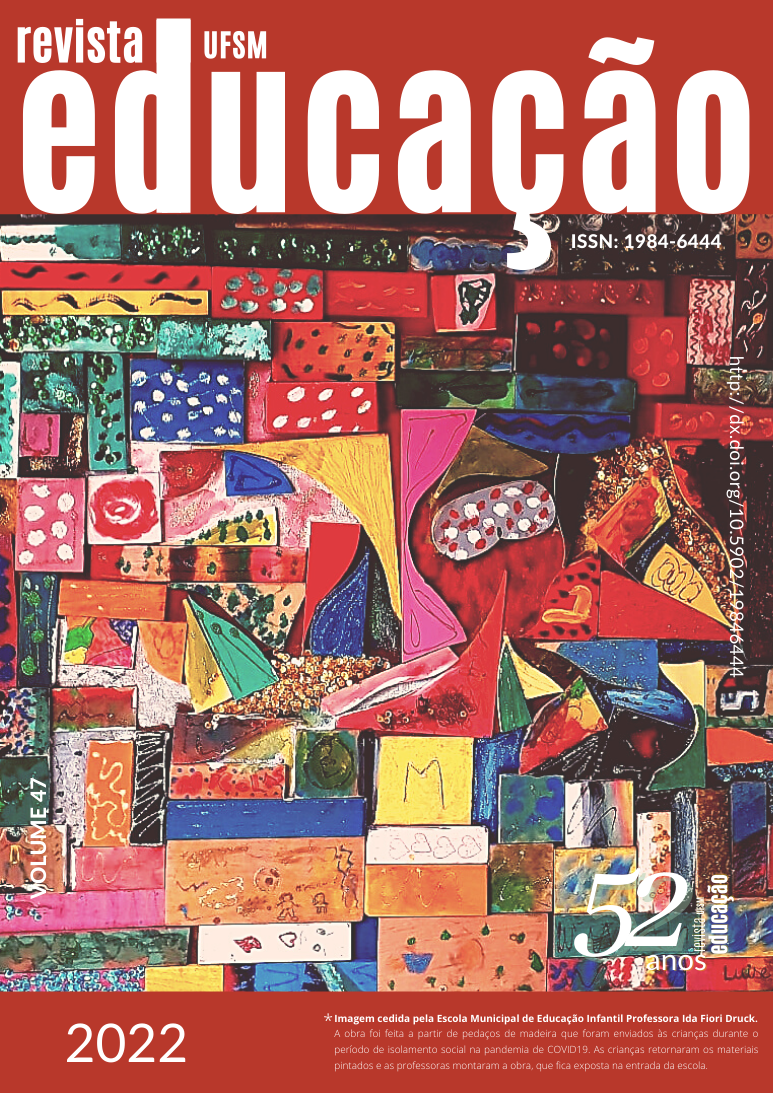The dance course in education and the escolinha de arte do Brasil (Rio de Janeiro, 1970 -1975)
DOI:
https://doi.org/10.5902/1984644453291Keywords:
Philosophy of Dance Teaching, Teaching of School Dance, Escolinha de Arte do Brasil/EABAbstract
This dance/educational research aims to understand the Dance Course in Education organized by the Escolinha de Arte do Brasil (EAB), in Rio de Janeiro, between the years 1970 and 1975. Initially, we tried to build a theoretical dialogue according to the socio-philosophical currents that underlie the studies on Brazilian School Dance Teaching, based on the researches developed by teachers Adriana Gehres (2008) and Ana Paula Abrahamian Souza (2010). Subsequently, we will present the two sequences of educational movements entitled: (1) A dialogue about Dance and its teaching in the Escolinha de Arte do Brasil - EAB and in the Movimento Escolinhas de Arte - MEA, and (2) The Dance Course in Education – CDE. In the first sequence, we will present a small clipping on the history of the EAB and the MEA, approaching how the Teaching of Dance is contemplated in this movement. In the second sequence, we describe the ideals of the Dance Course in Education, its organization and the period that it was accomplished. During this period, the dance teacher Maria Fux was responsible for mediating the teaching-learning processes of this artistic language in the course. As a result of the research carried out, we noticed similarities between the artistic/dancing practices developed by the CDE and the empiricist assumptions in Dance. Thus, we expose reflections, showing also a direct dialogue with the proposals indicated by the North American dancer Isadora Duncan (1877-1927).
References
BACARIN, Lígia; NOMA, Amélia. História do Movimento de Arte-Educação no Brasil. XXII Simpósio Nacional de História – Londrina, 2005.
BARBOSA. Ana Mae. Arte Educação no Brasil: do modernismo ao pós-modernismo. São Paulo, 2003.
BARBOZZA, Alexsander; DAMASCENO, Letícia. Maria Fux e sua proposta de Ensino para Educação Escolar. 2020a.
BARBOZZA, Alexsander; DAMASCENO, Letícia. O Ensino de Dança Empirista no Brasil.2020b.
BARBOZZA, Alexsander; SILVA, Everson. O Ensino de Dança na BNCC do Ensino Médio: retrocessos, permanências e avanços. Trabalho de Conclusão. Curso de Dança – Universidade Federal de Pernambuco. 2019.
FUX, María. Dança, Experiência de Vida. (N. Abreu; Silva N, Trad). São Paulo: Editora Summus Editorial.1983. (Original publicado em 1976).
FUX, María. Dançaterapia. (B. A. Cannabrava, Trad.) – São Paulo:Editora Summus Editoria. 1988.(Original publicado 1982).
GERHES, A. de F. Corpo-Dança-Educação: na contemporaneidade ou da construção de corpos fractais. Instituto Piaget. 2008.
HUTCHEON, Linda. A incredulidade a respeito das metanarrativas: articulando pós-modernismo e feminismos. Labrys: estudos feministas. Brasília, n. 1-2, 2002.
LIMA, Sidiney. P. F. de. Escolinha de Arte do Brasil: movimentos e desdobramentos. XXI Encontro da ANPAP, p. 454- 466, 2012.
MARQUES, Isabel. Dançando na Escola. Revista Motriz (UNESP),v.3, p. 20-28, 1997.
MARQUES, Isabel. Corpo, Dança e educação contemporânea. Pró-Posições (UNICAMP. Impresso), v.9, p. 70-78, 1998.
MARQUES, Isabel. Revisitando a dança educativa moderna de Rudolf Laban. Sala Preta (USP), v.2, p. 276-281, 2002.
MARQUES, Isabel. Dançando na Escola. São Paulo: Cortez, 2003.
MARQUES, Isabel. Ensino de dança hoje: textos e contextos. São Paulo: Cortez, 2007.
MARQUES, Isabel. Linguagem da Dança: arte e ensino. 1ª ed. São Paulo: Digitexto, 2010.
MIRANDA, Orlando. Coletânea do Jornal de Arte e Educação. Capa Ziraldo - Rio de Janeiro. 2009.
MIRANDA, Regina. Corpo-espaço: aspectos de uma geofilosofia do corpo em movimento. Rio de Janeiro: 7Letras, 2008.
NAVAS, Cássia; DIAS, Linneu. Dança Moderna. São Paulo: Secretária Municipal de Cultura, 1922.
PACHECO, José A. Escritos Curriculares. Cortez, 2005.
PAIVA, Warla G. Maria Duschenes: Teias de Saberes e Encontros. Dissertação de Mestrado. Universidade Federal de Goiás. Escola de Musica e Artes Cênicas. 2015.
PRESTON-DUNLOP, Valery. A handbook for dance in education. London: Longman, 1998.
SANTIN, Janaína Rigo; MARCANTE, Sheron. Microfísica do poder e poder local. Revista Brasileira de História & Ciências Sociais, v. 6, n. 11, p. 161-184.2014.
RIBEIRO, Djamila. Quem tem medo do feminismo negro?. 1ª ed. - São Paulo: Companhia de Letras, 2018.
RODRIGUES, Augusto (org.). Escolinha de Arte do Brasil. Brasília: Inep, 1980.
SOUZA, A. P. A. de. Corpos que dançam dentro e fora da escola: discursos pela interculturalidade na dança no ensino. Dissertação de Mestrado. Universidade Federal de Pernambuco. Centro de Educação – CE. 2010.
STINSON, Susan. Seeking a feminist pedagogy for children’s dance. In: SHAPIRO, Sherry. Dance, Power and difference: Critical and feminist perspectives on dance education. Champaign: HumanKinetics, 1998.
STINSON, Susan. Uma pedagogia feminista para dança da criança. Pro-posições. Vol. 6, 3 (18), p. 77-89: Campinas, 1995.
TAYLOR-SHAPIRO, Sherry. Dance, Power and Difference: critical and feminist perspectives on dance education. Champaign: HumanKinetics, 1998.
TAYLOR-SHAPIRO, Sherry. Toward transformati veteachers: critical and feminist perspectives in dance education. Pro-posições, n. 9, p. 35-45: Campinas,1996.
This work is licensed under a Creative Commons Attribution-NonCommercial 4.0 International (CC BY-NC 4.0)
Published
How to Cite
Issue
Section
License
Declaration of originality
We declare that all articles present in the journal Educação (UFSM) are originals and were not submitted for publishing on any other publication, as a whole or a fraction. We also declare that, after being published by Educação (UFSM), a paper will not be submitted to another journal within two years. After this time, our journal transfers the publishing rights to the authors, with a permit granted by the Editorial Council.
We also acknowledge that the originals’ submission to Educação (UFSM) implies on a transference of copyright for physical and digital publishing to the journal. In case of noncompliance, the violator will receive sanctions and penalties predicted by the Brazilian Copyright Protection Law (n. 9610, dated 19/02/98).
Attribution 4.0 International (CC BY 4.0)
This license lets others remix, transform, and build upon the material for any purpose, even commercially, and copy and redistribute the material in any medium or format.

This work is licensed under a Creative Commons Attribution 4.0 International (CC BY 4.0)






